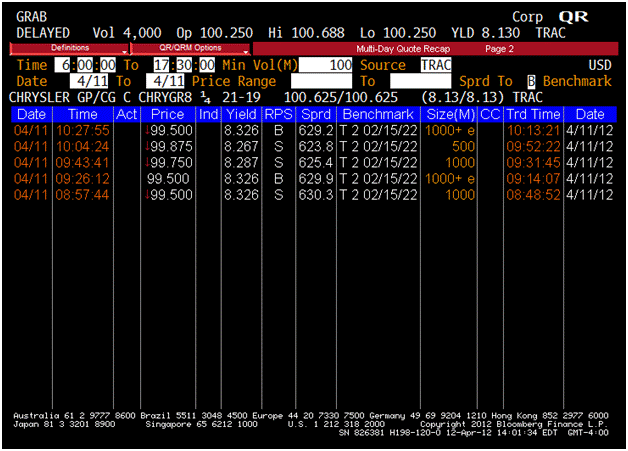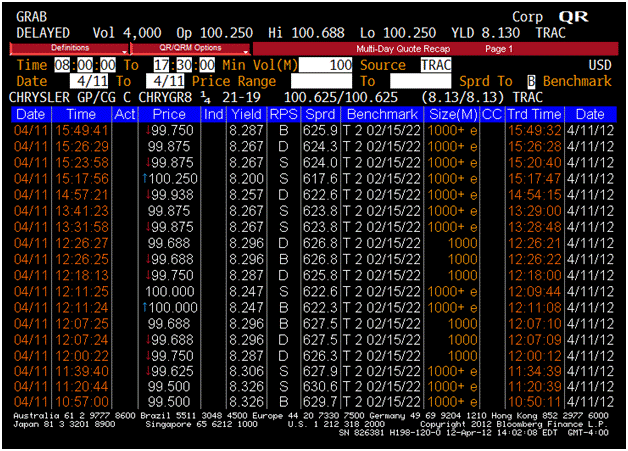One HY Bond’s trades on One Day
Blackrock announced a new platform to allow customers to trade bonds directly. It is not very detailed, but from what I know, it is targeting corporate bonds, and HY bonds in particular. There seems to be a lot of discussion of whether or not this is necessary, useful, or will succeed. I am not sure whether this will succeed. I see a couple of potential flaws, but let’s look at why they even took the time to develop something like this.
This bond was the second most active bond yesterday, and is right up there again today, according to TRACE.

So it looks like a dealer sold $1 million bonds at 99.50. Some dealer (could be the same one or another one) bought more than a million bonds at 99.50 (the reporting I get only has that it is > 1 million). It looks like that dealer (though it could have been another one) sold those bonds at 99.75 and 99.875. Given the time stamps it is likely someone was taking risk on these trades (crossed trades should show up within 15 minutes of each other on TRACE timestamps). A ¼ point on $1 million bonds is $2,500 as a point of reference.
A dealer was now able to buy bonds at 99.50.

Then more bonds were bought by a dealer at 99.50. Dealers then sold bonds at 99.50 and 99.625.
This next series of trades is interesting. A dealer “hits” a “street” bid at 99.75. The “aggressor” pays the brokerage of 1/16, so the “interdealer” broker buys bonds at 99 11/16 from the dealer that sold and then sells the bonds to the dealer with the bid at 99.75. Interdealer brokers only talk to dealers – or at least are only supposed to.
It then looks like a dealer bought bonds from a client at 99 11/16. A weird price for a client trade, my guess is that some client tried to hit the dealer at 99 ¾, but since they got hit in the street, the trader flaked, but the salesperson “fought” for the client and made the trader pay the price of the last “print”.
Now it looks like a dealer paid 100 for some bonds, and another dealer sold at 100. Notice the price going up, and gapping up a bit after “Europe went home”, just like equities did.
The dealer who paid 100 seems too high, because shortly thereafter you see another 99.75 bid hit in the street, and once again, a dealer buying at same price as client. If I didn’t “know” better, it looks like a dealer is working with a client to get that client “street” execution. Though the dealer print that goes in later might be the other side, in which case it looks like they delayed putting it in.
The timestamps are either a bit confusing here, or a customer is trading with the street, because the 99.875 print and 99 15/16 print, look a lot like someone “lifted” at 99 7/8 offer. As the aggressor they would pay 99 15/16 and the seller would only receive 99 7/8 (so the interdealer broker makes the 1/16th again).
Now we see a dealer sale at 99.875. Then some lucky dealer managed to sell bonds at 100.25. Likely some client was responding to a par offer, but the dealer said everything was getting lifted, and jacked the price up. The client likely panicked and was scared that by the time he called some other dealer, they too would have jacked up the prices. Or maybe this client was working with the dealer who paid par (when he shouldn’t have).
In any case, it then looks like a dealer sold bonds at 99.875. He (or she) was probably cursing at the salesforce wondering why they couldn’t get the 100.25 sucker to trade.
The day ends with a dealer being able to buy bonds at 99.75.
This trading is all done on the back of bloomberg messages and phone calls. There is no central market. If there was, no one would have paid 100.25, and enough timestamps occur within a 15 minute span that much of the trading looks like it was done riskless.
This is all for a liquid bond. I ignored the odd lot trades in the bonds. There were only a few, but it looks like the high print went to some small buyers who paid 102 or more for the bonds. So although small sizes, it looks like at least $100k of bonds went through at least 2% above the round lot size. Not horribly exciting, but beats digging ditches for a living. There did not appear to be a single retail (odd-lot) seller of this bond all day. What other market always penalizes small orders?
The costs to “customers” are the bid/offer that is charged for orders and the cost of buying a bond that is offered more cheaply away (or selling a bond into a bid, when there is a better bid away). This market looks nothing like a “market” and I believe that you will see new entrants (and existing participants) looking for new ways to make money by finding a better way to trade and sharing part of that benefit with clients, while having more than enough left over to make real money.
Again, I’m not sure this platform will work, and there are some key issues that need to be addressed for any platform to be truly successful. New Issues are a big part of that. One recent issue, HD Supply is just a simple example. It is a $950 million issue, came at par, is 101.5 basically on the break. That is $14.5 million in the pockets of those who got allocated bonds and kept them until now. That is not a particularly “successful” deal. Think about the size of the new issue calendar this year. How many billions have been issued? If on average they go up 1% on the break, how much money has been handed out? This isn’t like equities. You don’t see bonds break 50%, but virtually every single day, you have billions coming into the market, and generally they are priced to trade up on the break. That is a lot of money and controlling the allocation process gives a lot of power when one of your customers starts “trading away”.
